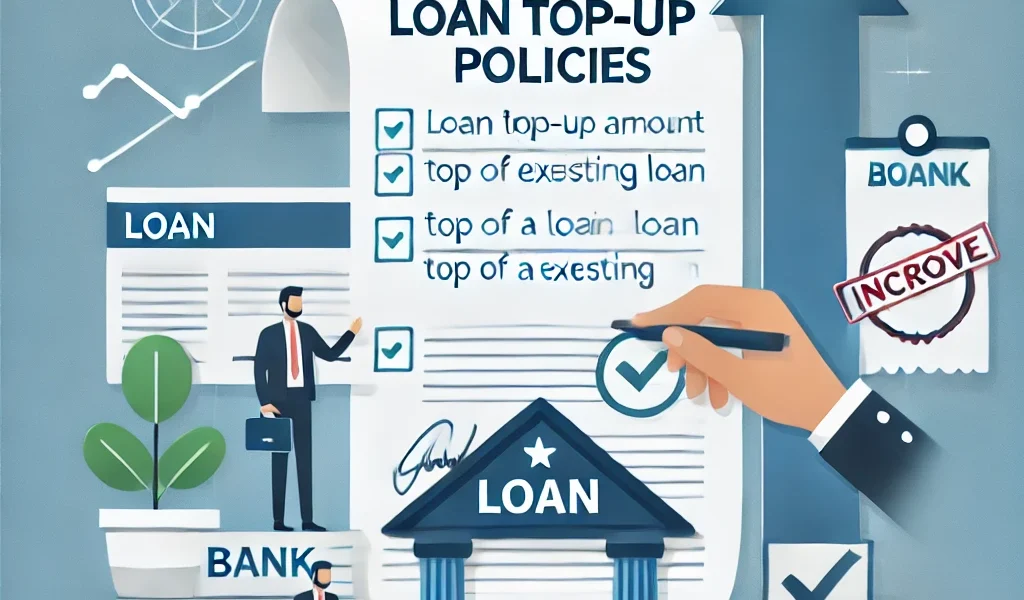Introduction
In times of financial need, borrowers often look for ways to access additional funds without going through the hassle of applying for a new loan. This is where loan top-up policies come into play. A loan top-up allows existing borrowers to increase their loan amount under predefined conditions set by banks and financial institutions. Understanding the eligibility, benefits, and application process for a loan top-up can help borrowers make informed financial decisions.
This article covers everything you need to know about loan top-up policies, including when you should apply, how the process works, and key considerations to keep in mind.
1. What is a Loan Top-Up?
A loan top-up is an additional loan amount that a borrower can avail of on an existing loan. This facility is typically available for home loans, personal loans, and business loans, subject to the borrower’s repayment history and creditworthiness.
Key Features of Loan Top-Up Policies
- Available only to existing borrowers with an active loan.
- Subject to the borrower’s repayment track record and eligibility.
- Generally comes with a lower interest rate compared to fresh loans.
- Loan tenure usually extends along with the existing loan term.
- Minimal documentation and fast processing.
2. When Should You Apply for a Loan Top-Up?
A loan top-up can be a smart financial decision in several situations. Here are some common scenarios where borrowers opt for a loan top-up:
1. Need for Additional Funds
If you require additional money for purposes like home renovation, medical emergencies, or business expansion, a loan top-up can provide quick financial relief.
2. Better Interest Rates than New Loans
Top-up loans generally come with lower interest rates compared to fresh loans, making them a cost-effective way to borrow additional funds.
3. Debt Consolidation
Borrowers can use a top-up loan to consolidate multiple debts into a single loan with better repayment terms, reducing financial burden.
4. Improved Creditworthiness
If you have maintained a good repayment history, lenders may offer you a top-up loan at attractive interest rates.
3. Who is Eligible for a Loan Top-Up?
While loan top-up policies vary across lenders, the general eligibility criteria include:
| Criteria | Requirement |
|---|---|
| Existing Loan Status | Must have an active loan with the lender |
| Repayment History | No history of missed or delayed payments |
| Credit Score | Preferably 750+ to qualify for better terms |
| Loan Tenure | Typically, the top-up is granted for a tenure matching or lower than the existing loan |
| Lender’s Policy | Each lender has specific eligibility requirements |
4. How to Apply for a Loan Top-Up?
Applying for a loan top-up is relatively simple and involves the following steps:
Step 1: Check Eligibility
Contact your bank or lender to confirm if you qualify for a top-up loan based on your repayment history and creditworthiness.
Step 2: Choose Loan Terms
- Decide the additional amount you need.
- Compare interest rates offered on top-up loans.
- Choose a loan tenure that aligns with your financial goals.
Step 3: Submit Documentation
Most lenders require minimal documentation for a loan top-up. Typically, the required documents include:
- Loan account statement
- Income proof (salary slips or business financials)
- Updated KYC documents (ID and address proof)
Step 4: Approval and Disbursement
Once the lender reviews and approves your top-up loan application, the additional amount is credited directly to your account, usually within a few days.
5. Benefits of Loan Top-Up Policies
✅ Lower Interest Rates
- Top-up loans often have lower interest rates compared to personal loans or credit card debt.
✅ Quick Processing
- Since the borrower already has an existing relationship with the lender, the approval process is faster.
✅ No Collateral Requirement
- In most cases, no additional collateral is required for a loan top-up.
✅ Flexible Usage
- The borrowed amount can be used for any purpose, including medical expenses, education, or home improvements.
6. Things to Consider Before Taking a Loan Top-Up
While loan top-ups offer multiple benefits, borrowers should evaluate the following factors before applying:
1. Interest Rate Comparison
- Ensure that the top-up loan offers better interest rates compared to other loan options available in the market.
2. Impact on EMI and Loan Tenure
- Increasing the loan amount may lead to a higher EMI or longer repayment period.
3. Processing Fees and Additional Charges
- Some banks may charge processing fees for top-up loans, so check for any hidden costs.
4. Alternative Financing Options
- Compare other financing options like credit lines, personal loans, or home equity loans to determine the most cost-effective choice.
7. Loan Top-Up vs. Personal Loan: Which One is Better?
| Feature | Loan Top-Up | Personal Loan |
| Eligibility | Existing borrowers only | Any eligible applicant |
| Interest Rate | Lower | Higher |
| Processing Time | Faster | Standard approval time |
| Usage Flexibility | High | High |
| Loan Tenure | Matches existing loan | 1-5 years |
| Documentation | Minimal | More extensive |
A loan top-up is preferable if you already have an existing loan and meet the eligibility criteria. However, if you need funds but do not have an active loan, a personal loan may be a better option.
Conclusion
Loan top-up policies offer a convenient and cost-effective way to access additional funds without applying for a new loan. By understanding the eligibility criteria, benefits, and potential risks, borrowers can make informed decisions and effectively manage their financial needs. Before applying, compare lenders, review interest rates, and evaluate repayment capabilities to ensure a hassle-free borrowing experience.
If used wisely, a loan top-up can provide significant financial flexibility and help borrowers meet their urgent financial requirements without excessive debt burden.




